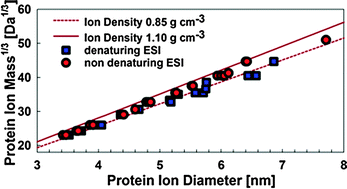Determination of gas phase protein ion densities via ion mobility analysis with charge reduction
Abstract
We use a charge

* Corresponding authors
a
Department of Mechanical Engineering, University of Minnesota, Minneapolis, MN, USA
E-mail:
hogan@me.umn.edu
Fax: 1-612-625-6069
Tel: 1-612-626-8312
b Faculty of Physics, University of Vienna, Vienna, Austria
c Faculty of Physics, University Paris-Créteil Val de Marne East, Paris, France
We use a charge

 Please wait while we load your content...
Something went wrong. Try again?
Please wait while we load your content...
Something went wrong. Try again?
A. Maißer, V. Premnath, A. Ghosh, T. A. Nguyen, M. Attoui and C. J. Hogan, Phys. Chem. Chem. Phys., 2011, 13, 21630 DOI: 10.1039/C1CP22127B
To request permission to reproduce material from this article, please go to the Copyright Clearance Center request page.
If you are an author contributing to an RSC publication, you do not need to request permission provided correct acknowledgement is given.
If you are the author of this article, you do not need to request permission to reproduce figures and diagrams provided correct acknowledgement is given. If you want to reproduce the whole article in a third-party publication (excluding your thesis/dissertation for which permission is not required) please go to the Copyright Clearance Center request page.
Read more about how to correctly acknowledge RSC content.
 Fetching data from CrossRef.
Fetching data from CrossRef.
This may take some time to load.
Loading related content
